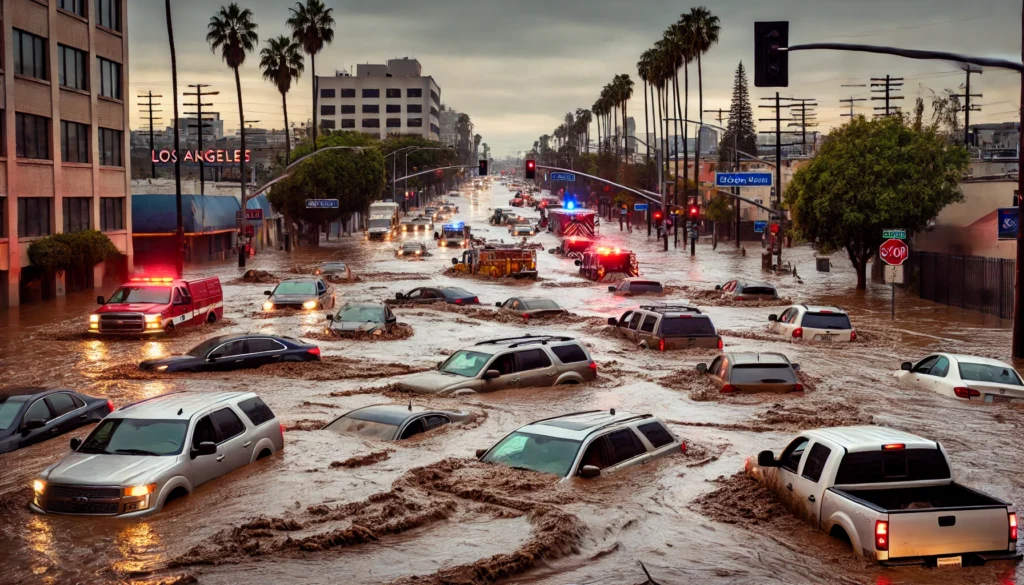Southern California faced its most intense rainfall in over a year this week, as torrents of mud and floodwater inundated roads, trapped vehicles, and triggered debris flows across Los Angeles. While the storm spared wildfire-scarred regions from catastrophic damage, it left a trail of localized destruction, forcing evacuations and testing the resilience of communities.
The atmospheric river-fueled storm, which has since moved out of California, dropped more rain on Los Angeles in a single day than the city had seen in the past nine months combined. The heaviest downpour occurred late Thursday afternoon, prompting flash flood warnings and a rare severe thunderstorm alert from the National Weather Service. Winds reached up to 60 mph, exacerbating the chaos.
Mudslides and Debris Flows Cause Havoc
The storm’s impact was felt across the region, particularly in areas near recent wildfire burn scars, such as the Eaton and Palisades fire zones. In the Hollywood Hills, a massive debris flow dumped approximately 8 inches of mud across Mulholland Drive, rendering the road impassable. Altadena, still recovering from the Eaton Fire, saw vehicles stuck in thick mud as emergency crews worked tirelessly to free them.

Sierra Madre, another community near the Eaton burn scar, experienced mud cascading down hillsides, overtaking cars and forcing residents to band together to clear debris. Francisco Martinez, a local resident, described the scene as unprecedented. “The debris flow, the mud … I’ve never seen it like this,” he told CNN affiliate KCAL/KCBS.
Close Calls and Community Resilience
The storm brought harrowing moments for some. In Malibu, a Los Angeles Fire Department member was swept off a roadway by a debris flow and into the ocean, sustaining minor injuries. Nearby, a vehicle was partially submerged after being pushed off an embankment. Significant debris flows were also reported near Duke’s restaurant along the Pacific Coast Highway, though the iconic oceanfront eatery escaped damage.
In Azusa, a portion of the roof at a Smart & Final grocery store collapsed, startling shoppers. “It was crazy,” said Al Hernandez, who witnessed the incident. “People were screaming and running, it was just madness.” Fortunately, no injuries were reported.
Meanwhile, in San Bernardino County, three dogs were trapped inside a flooded home in Highland while their owners were out of town. Friends of the family attempted a rescue but could only save one dog. “The door was so swollen on the bottom half that I couldn’t open it,” said Ramona Hernandez, one of the rescuers. Efforts to retrieve the remaining two dogs are planned for Friday.
Evacuations and Lingering Threats
Although the worst of the storm has passed, some evacuation orders remain in effect for residents near burn scar areas through Friday afternoon. Officials warn that mudslides and rockslides can occur even after rainfall ends, posing ongoing risks. The Los Angeles Fire Department continues to monitor the situation, urging caution in vulnerable zones.
Storm Shifts East, Bringing New Dangers
As California begins to recover, the same storm system is now tracking eastward, bringing snow, rain, and the threat of severe weather to the Plains and beyond. By Saturday, the storm is expected to unleash extensive flooding from the Gulf Coast to the Northeast, with over 500 miles of the country under a level 3 of 4 risk for flooding rainfall.
The South faces additional dangers, as severe thunderstorms with damaging winds and tornadoes are predicted for parts of Louisiana, Arkansas, Mississippi, Tennessee, and Alabama. The Storm Prediction Center has issued a level 3 of 5 risk for severe weather in these areas, particularly from late Saturday afternoon through the overnight hours.
A Narrow Escape for Los Angeles
While Los Angeles avoided the worst-case scenario, the storm served as a stark reminder of the region’s vulnerability to extreme weather. The resilience of its communities shone through as neighbors helped one another dig out of the mud and debris. Yet, the event underscores the need for continued preparedness, especially in areas still recovering from wildfires.
As cleanup efforts continue, Californians are breathing a sigh of relief, knowing that this storm could have been far worse. However, with climate change increasing the frequency and intensity of such events, the state must remain vigilant in the face of future challenges.
For now, the focus shifts to the eastern U.S., where the same storm system threatens to bring a new wave of destruction. Stay tuned for updates as this developing story unfolds.



